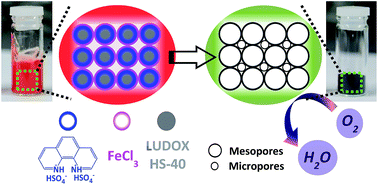当前位置:
X-MOL 学术
›
J. Mater. Chem. A
›
论文详情
Our official English website, www.x-mol.net, welcomes your
feedback! (Note: you will need to create a separate account there.)
Simple combination of a protic salt and an iron halide: precursor for a Fe, N and S co-doped catalyst for the oxygen reduction reaction in alkaline and acidic media†
Journal of Materials Chemistry A ( IF 10.7 ) Pub Date : 2017-12-11 00:00:00 , DOI: 10.1039/c7ta09975d Mahfuzul Hoque 1, 2, 3, 4 , Shiguo Zhang 1, 2, 3, 4 , Morgan L. Thomas 1, 2, 3, 4 , Zhe Li 1, 2, 3, 4 , Soma Suzuki 1, 2, 3, 4 , Ayumi Ando 1, 2, 3, 4 , Masato Yanagi 1, 2, 3, 4 , Yoshio Kobayashi 4, 5, 6, 7 , Kaoru Dokko 1, 2, 3, 4 , Masayoshi Watanabe 1, 2, 3, 4
Journal of Materials Chemistry A ( IF 10.7 ) Pub Date : 2017-12-11 00:00:00 , DOI: 10.1039/c7ta09975d Mahfuzul Hoque 1, 2, 3, 4 , Shiguo Zhang 1, 2, 3, 4 , Morgan L. Thomas 1, 2, 3, 4 , Zhe Li 1, 2, 3, 4 , Soma Suzuki 1, 2, 3, 4 , Ayumi Ando 1, 2, 3, 4 , Masato Yanagi 1, 2, 3, 4 , Yoshio Kobayashi 4, 5, 6, 7 , Kaoru Dokko 1, 2, 3, 4 , Masayoshi Watanabe 1, 2, 3, 4
Affiliation

|
The major bottleneck for widespread realization of fuel cells has been the usage of precious-metal-based electrocatalysts, such as Pt/C or Pt-alloy/C, at the cathode. Owing to the high cost and limited natural resources of platinum, nonprecious metal catalysts, such as iron-doped carbons, have emerged as promising substitute catalyst materials. Protic salts and protic ionic liquids can provide a simple, quick, and cost-effective approach for fabricating iron-doped carbons without any additives or high-surface-area carbon supports. We demonstrate here the fabrication of an efficient electrocatalyst based on a protic salt, 1,10-phenanthrolinium dihydrogen sulfate ([Phen][2HSO4]), in combination with iron(III) chloride, FeCl3, via nanocasting. A predominantly mesoporous architecture with a narrow pore size distribution was achieved owing to the suitability of the precursors and silica template. The material also exhibited in situ formation of Fe–N bonds in the nitrogen and sulfur co-doped carbons. We found that maximizing the content of this motif was beneficial towards efficient conversion of oxygen into water in alkaline media. The prototype catalyst after post treatment (acid leaching and 2nd carbonization) also exhibited efficient reduction of oxygen in acidic media. The contribution of Fe–N bonds to the observed activity in acidic solution was less than in alkaline solution. The simplicity of the synthesis of the protic salt and the versatility of the ionic liquid platform make this molecular-level carbon precursor a unique candidate for future development of iron doped catalysts for fuel cells.
中文翻译:

质子盐和卤化铁的简单组合:Fe,N和S共掺杂催化剂的前体,用于碱性和酸性介质中的氧还原反应†
燃料电池广泛实现的主要瓶颈是在阴极处使用诸如Pt / C或Pt合金/ C之类的贵金属基电催化剂。由于铂的高成本和有限的自然资源,非贵金属催化剂,例如掺杂铁的碳,已经成为有前途的替代催化剂材料。质子盐和质子离子液体可以提供一种简单,快速且经济高效的方法来制造掺杂铁的碳,而无需任何添加剂或高表面积碳载体。我们在这里展示的有效电的基于质子盐,1,10-菲咯啉硫酸盐二氢制造([Phen的] [2HSO 4 ]),在用铁(组合III),氯化的FeCl 3,通过纳米铸造。由于前体和二氧化硅模板的适用性,获得了具有窄孔径分布的主要介孔结构。该材料还表现出在氮和硫共掺杂碳中原位形成Fe–N键。我们发现最大程度地增加此图案的含量有助于在碱性介质中有效地将氧气转化为水。后处理后的原型催化剂(酸浸和第二次碳化)也表现出在酸性介质中氧气的有效还原。在酸性溶液中,Fe–N键对观察到的活性的贡献小于在碱性溶液中。质子盐合成的简单性和离子液体平台的多功能性使得这种分子级碳前体成为燃料电池铁掺杂催化剂未来发展的独特候选者。
更新日期:2017-12-11
中文翻译:

质子盐和卤化铁的简单组合:Fe,N和S共掺杂催化剂的前体,用于碱性和酸性介质中的氧还原反应†
燃料电池广泛实现的主要瓶颈是在阴极处使用诸如Pt / C或Pt合金/ C之类的贵金属基电催化剂。由于铂的高成本和有限的自然资源,非贵金属催化剂,例如掺杂铁的碳,已经成为有前途的替代催化剂材料。质子盐和质子离子液体可以提供一种简单,快速且经济高效的方法来制造掺杂铁的碳,而无需任何添加剂或高表面积碳载体。我们在这里展示的有效电的基于质子盐,1,10-菲咯啉硫酸盐二氢制造([Phen的] [2HSO 4 ]),在用铁(组合III),氯化的FeCl 3,通过纳米铸造。由于前体和二氧化硅模板的适用性,获得了具有窄孔径分布的主要介孔结构。该材料还表现出在氮和硫共掺杂碳中原位形成Fe–N键。我们发现最大程度地增加此图案的含量有助于在碱性介质中有效地将氧气转化为水。后处理后的原型催化剂(酸浸和第二次碳化)也表现出在酸性介质中氧气的有效还原。在酸性溶液中,Fe–N键对观察到的活性的贡献小于在碱性溶液中。质子盐合成的简单性和离子液体平台的多功能性使得这种分子级碳前体成为燃料电池铁掺杂催化剂未来发展的独特候选者。











































 京公网安备 11010802027423号
京公网安备 11010802027423号